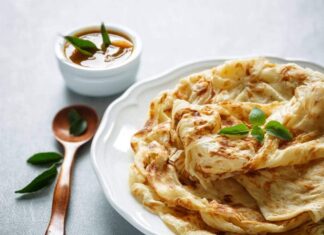Clean and simple lines, floral designs, and wall art characterize Asian-style kitchen design. Most Asian-influenced kitchens have light stone tiles, wood elements, and even rocks or pebbles.
Natural tones like tan, black, gray, brown, and green contribute to the peaceful and calming effect. Asian-style houses traditionally utilize this design style.
However, modern homes may also feature this design trend. A kitchen with an Asian influence is a very particular look that appeals to certain home buyers.
What is Asian Style Kitchen Design
Asian style uses influences from the Far East, is not limited to one country, and spans centuries. Asian design draws on Chinese, Japanese, Korean, and Vietnamese traditions.
Although many Asian cultures share the tradition of gathering the family to socialize over a meal, each culture has developed its own cuisine and influences from the kitchen style.
Homeowners can choose from different elements of each culture to create a harmonious design. For example, an Asian-influenced kitchen can blend elements from different Asian countries.
Asian-style kitchens are popular in homes and food trucks, where the quality of food, portion sizes, and friendly service are emphasized.
What Defines Asian-style Kitchens
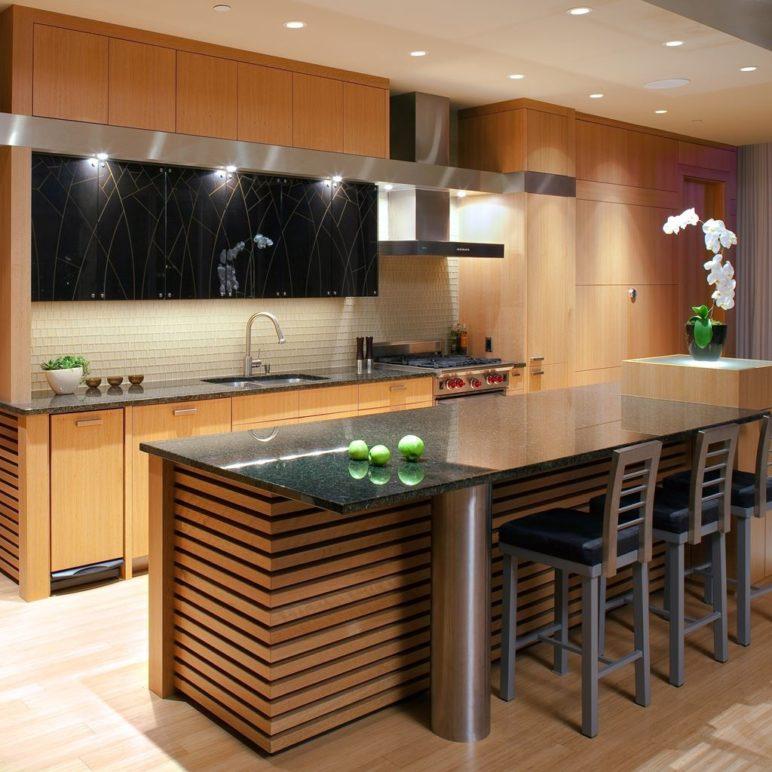
Asian design is a minimalist space with organic materials and plenty of natural light. It is open, uncluttered, and perfectly balanced. The use of natural materials is common in Asian-influenced homes.
The goal here is to get closer to nature with the décor. That is why many of these designs include orchids, which are a strong symbol in Asian countries. Orchids have been a source of herbal remedies in China for thousands of years.
Another characteristic of Asian design is clean lines. Every piece of furniture is simple and straight. The decorative details complement the clean lines, so they are not overwhelming.
The result is a layered, minimalistic interior. The overall effect is pared-down, with a Zen atmosphere and a light and open feeling.
Natural light is also very important in this design concept, not only for brightness but for the connection to nature. Large, modern-style windows without panes, blinds, or curtains are common to allow natural light to pour through.
The art of feng shui has been practiced in many Asian cultures for hundreds of years, but is becoming more popular in Western ones. Feng shui is an ancient guideline from China regarding where to place objects.
The principle states that all objects have positive or negative energy and must be balanced. This principle also applies to the Asian home and kitchen.
Elements of an Asian Kitchen
The Asian kitchen is serene with a touch of the exotic. The kitchen should feel understated with a sleek and streamlined design. Homeowners who want an Asian kitchen should consider the following:
Asian Style Kitchen Cabinets

The Asian aesthetic values harmony, which is true for using materials in the design. Balancing the cabinets in color, form, and height is important. The cabinet layout is symmetrical, with cabinets of the same size.
The cabinets in an Asian kitchen have clean lines and are free of ornamentation. Shaker-style cabinets, with their clean, straight lines and minimalist characteristics, are ideal for creating a sleek and efficient Asian kitchen atmosphere.
Shaker cabinets work well because of their simple lines and lack of ornamentation. However, homeowners prefer frameless or flat-panel cabinets.
The color of the cabinets can be based on the rest of the kitchen design. White or black cabinets provide a neutral backdrop that works well with this kitchen style. Cabinets may be lacquered to achieve a modern sheen.
Asian Style Kitchen Color Palette
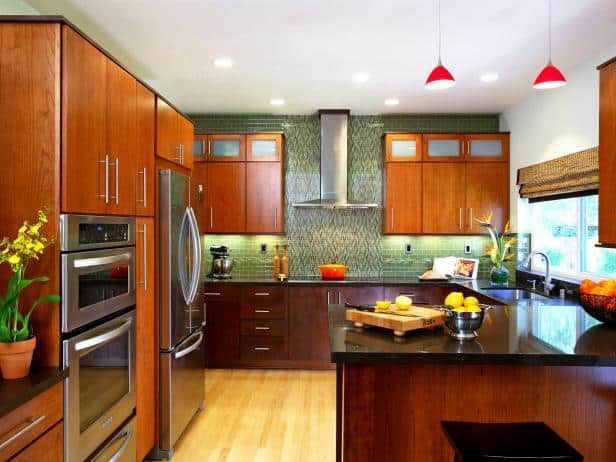
The overall feeling of a Zen Asian kitchen is calm. Natural tones like tan, black, gray, brown, and green are used to create a sense of serenity and balance in the kitchen. The color palette reflects this with the use of whites and soft neutrals.
Accent colors are darker ones that add depth to the room but never compete with the design. Gold or silver accent features highlight the contrast in these kitchens.
For example, jade green walls, bamboo flooring, black kitchen cabinets, and natural stone blend natural materials while keeping a soothing, neutral color palette.
Pops of color can be used sparingly in the space, but bright colors are those found in nature, such as green, blue, orange, or red. In this instance, a little goes a long way because the rest of the space is so calming.
Homeowners who only draw upon Chinese influence might choose black and red for a dramatic room. In fact, red is a symbolic color in many Asian cultures, signifying good fortune.
Asian décor is mostly monochromatic but will sometimes use small red accents. Asian kitchen commonly features monochromatic décor.
Asian Kitchen Countertops
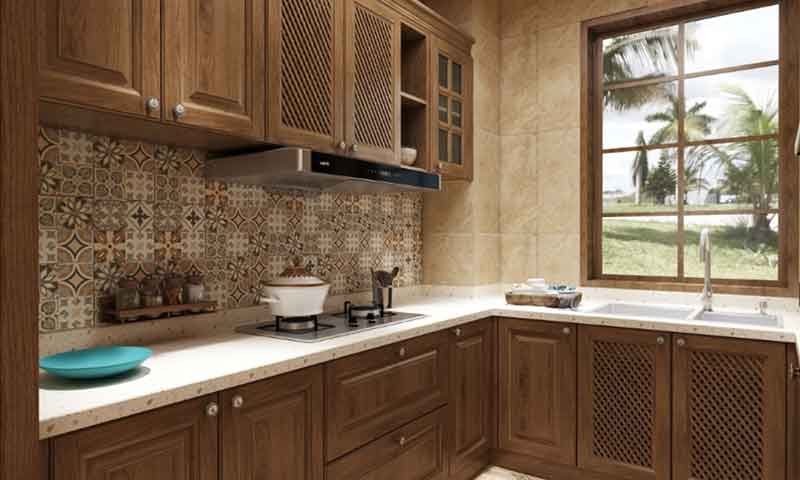
Countertop surfaces reflect a connection to nature. Examples are wood, stone, or butcher blocks. Granite and quartz are natural materials with advantages such as durability and easy maintenance.
Use contemporary materials balanced with natural elements, such as concrete or glass, to create a less harsh aesthetic.
The countertops act as a bold statement of color in an otherwise simple space. Dark-colored countertops, like black or dark gray, will complement the rest of the color scheme. In fact, black countertops are an upcoming trend in kitchens.
Asian Style Kitchen Backsplash
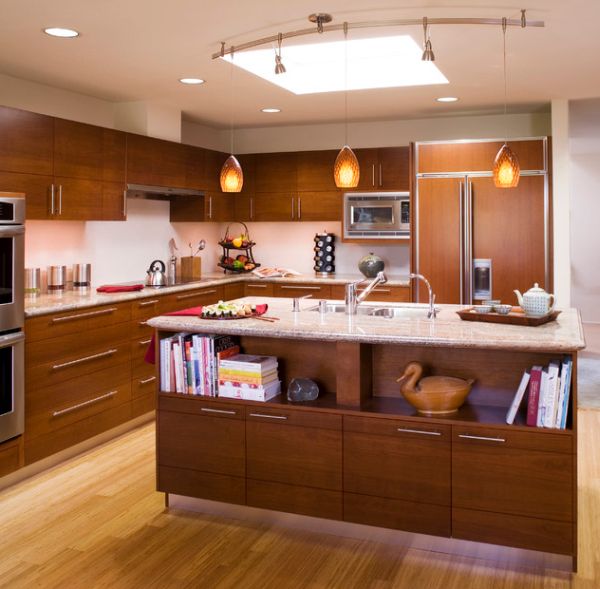
The backsplash is an opportunity to incorporate natural elements into the room.
For example, pebbled or stone backsplashes will achieve this.
Concrete tile can also work. The colors are often subtle and blend in with the rest of the space.
For a twist on an Asian-modern design, a clear glass backsplash can be laid over a painted, colored wall. Keep the remaining space completely neutral and monochromatic. One can let the backsplash be the one focal point.
Asian Kitchen Furniture & Decorations
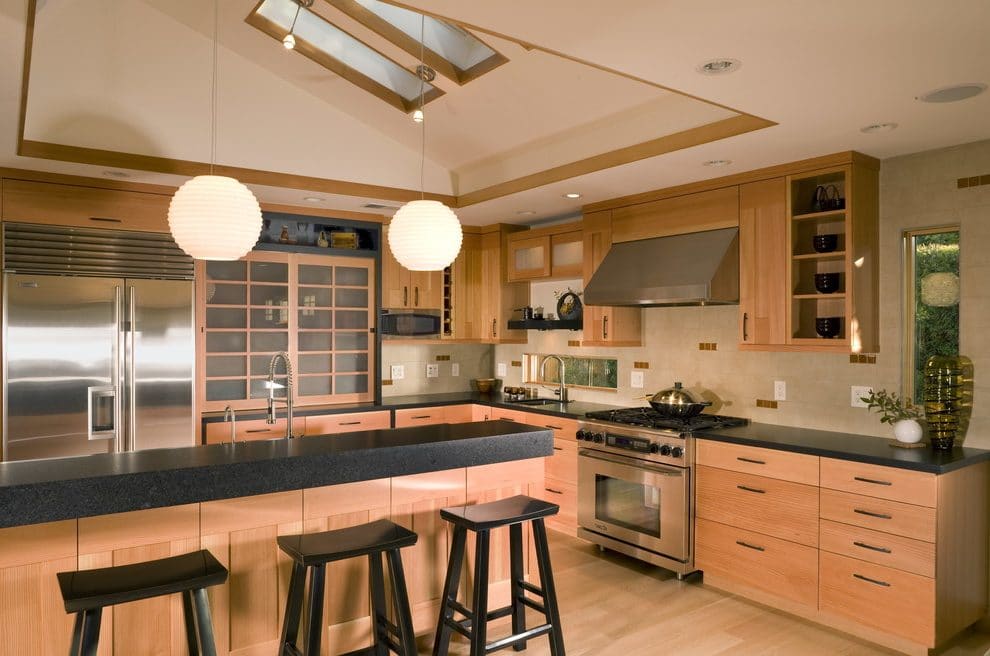
Asian furniture is often very simple, almost to the point of being austere, but it can also feature intricate details. For example, cabinets have painted lacquered finishes.
Clean lines with squares and rectangles are prevalent in furniture design, which adds to the simplicity of the space. For example, the stools on the kitchen island can be sleek and unique.
Furniture is geared toward living close to the floor. In an Asian kitchen, there may be an area designated as a tea space. This area includes a low table and several floor cushions with Asian patterns.
The belief is that sitting on a cushion or directly on the floor creates a greater connection with nature. Natural materials like silk are used for cushions and rugs with soft and natural hues.
One should have floating shelves to display a few Asian dishes or cooking pieces. Asian calligraphy is popular for its elegant strokes as art. Prints and wall hangings might incorporate calligraphy.
Asian Design Kitchen Lighting

As mentioned above, natural light is an important element in this design.
To allow for natural light, consider replacing smaller windows with larger ones in a complete kitchen design. Natural windows may be covered with neutral-colored blinds or left unadorned.
Artificial lights can replicate natural light, too. In traditional Japanese houses, main rooms, like the kitchen, face south to ensure sunlight throughout the day.
Standard light switches can be replaced with dimmers to control the room’s light, like the sun’s rising and setting. This helps to keep the room a relaxing space.
Asian kitchens might contain one element of drama, which might be seen in a statement lighting fixture. Dramatic light fixtures do not replace natural light; they only add to it.
Asian Design Kitchen Flooring

Wood is the most common material for flooring in Asian-style kitchens. Flooring tends to be organic and warm.
Asian-influenced kitchens often have plank hardwood floors with different color tones. Bamboo is a common choice, but stone flooring is a less common option.
Asian Kitchen Design Storage
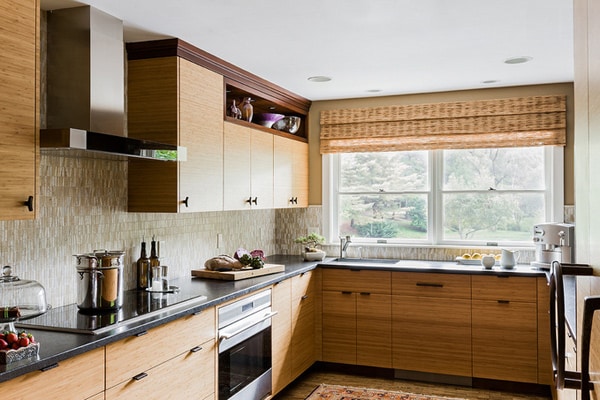
An Asian kitchen remodel is not complete without plenty of storage. Ample storage in Asian-styled kitchens is a key factor. Having access to storage maintains a minimalist look and uncluttered countertops.
Built-in storage is great for this as it blends into the décor without standing out. Multi-purpose and clever storage solutions do not detract from the Zen design.
Asian Style Sink
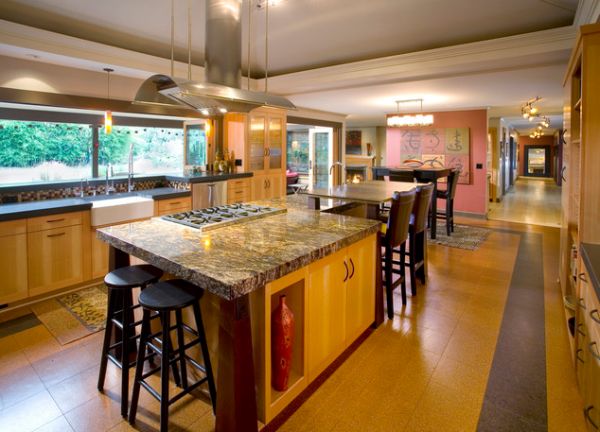
The sink is not a focal point of the kitchen and should fit the design.
A stainless steel undermount sink has clean lines, is functional, and does not detract from the neutrality of the space. Single versus double basins depend on the individual’s preference.
Unlike in other kitchen styles, the sink is not the focal point. A farmhouse sink is very rarely seen in an Asian kitchen design.
Asian Style Appliances
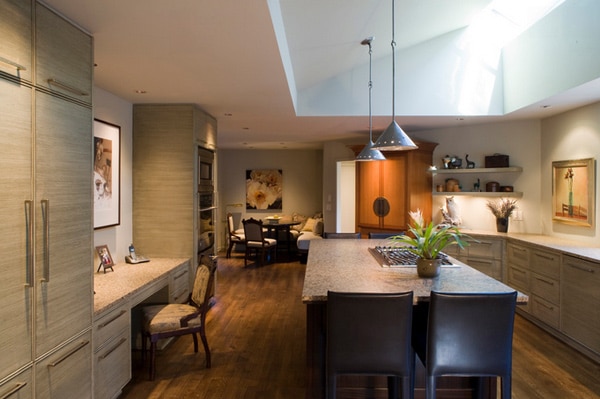
Similar to the sink, appliances should be sleek with clean lines. Up-to-date stainless steel appliances will blend well with the rest of the décor.
Asian-style kitchens default to having standard slide-in appliances. This opinion changes when one chooses to incorporate modern cabinetry.
What’s Next in Asian-Style Kitchens in 2025
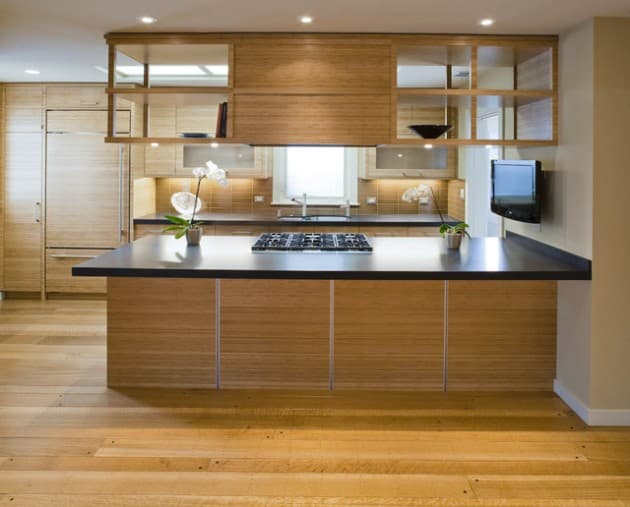
One upcoming kitchen trend that complements this design is a wooden kitchen backsplash, which is great for larger kitchens.
Different tones of wood bring an excellent natural element into the room. Many people use wooden planks for the ceiling in Asian-style kitchens.
Tapestries are another trendy wall decoration in Asian kitchen design. These decorations bring comfort to contemporary interiors.
A framed tapestry is one way to add variety and color to the room and is a great alternative to more traditional artwork. It also adds some warmth that many homeowners seek to remind them of simpler times.
The Asian-influenced kitchen evokes a soothing and calm feeling. Homeowners should choose sleek cabinets that fit well with this design.

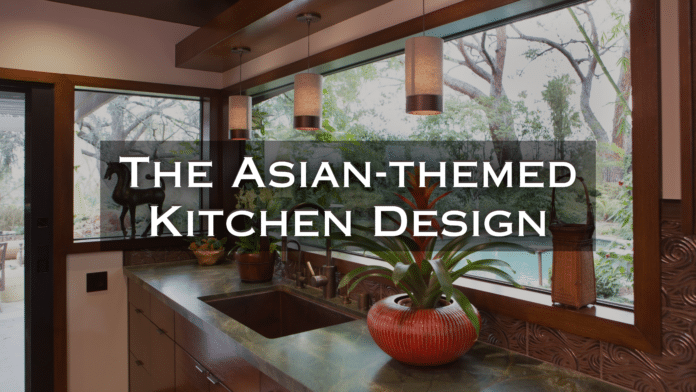

![How To Choose The Right Kitchen Cabinet Colors [2025 Guide] choosing the right kitchen cabinet colors](https://cdn.bestonlinecabinets.com/blog/wp-content/uploads/2025/10/Kitchen-Cabinet-Colors-218x150.png)




